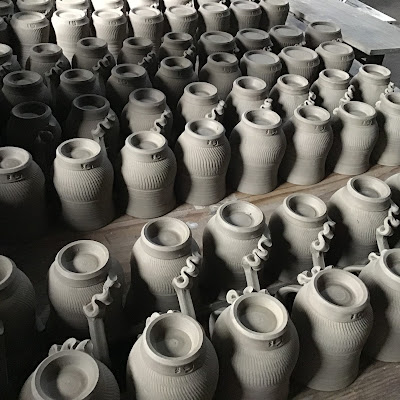The afternoon sunlight floods in through the studio windows as I finish the last of the handles. Spreading the wide end of a coned coil of clay with a few taps of my thumb, I moisten it with enough water to form a thin slurry then fold the wet surface over the rim of the mug and smear in the edges inside and out. I take extra care to confirm and compress the outer corners where it joins the rim, and with such a large surface area of contact, this join will become the strongest part of the pot.
Wetting my hand in a pail of well water, I gently caress the surface of the clay within the circle of my thumb and index finger, smoothing out the surface as gravity pulls it down. When the coil of clay has tapered evenly from the thickness of the joint to the thin end, I alternate my grip from side to side as I slide it down the length if the clay. This helps to form an oval profile, thicker in the centre than on the edges, giving the handle a backbone and making it stronger. Each stroke of my hand sliding across the wet surface of the clay aligns the the particles in the direction which the clay will eventually bend, adding to its tensile strength. With the end of my thumb I fashion groves down the handle, slight changes of direction which help stabilize the structure of the handle.
I rotate the cup in the horizontal plane, never swinging the handle for that would cause stress fractures, and add grooves to the internal surface of the handle as well. And, when the handle is just the right length, I lift the cup upright, and allow gravity and the tensile strength of the clay to form a perfect curve, then press the handle into the side of the body to join it back into the cup. The remaining strap of clay I fold and wind into the curve at the hip of the pot, and the very last end slides into the line at the top of the foot. Thus, the handle flows in a natural curve, springing from the rim and returning to the body in smooth and harmonious movement.
The trick is; not to interfere. The clay knows where it wants to go, gravity knows what it has to do, and once it is done, you must know when to let it be.
The art of the potter is not about controlling the clay and forcing your will upon it, but understanding the clay and helping it express its nature in harmony with universal forces.



No comments:
Post a Comment